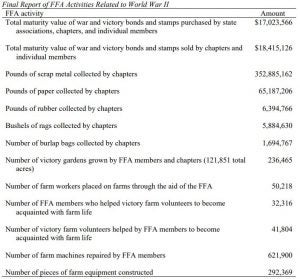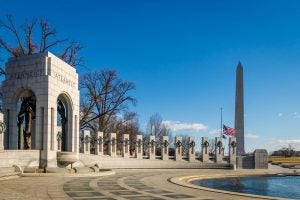For current FFA members, World War II might seem like just an event that happened in their textbooks. However, their organization — the National FFA Organization — was extremely active and important during this time in history. It took every person working together to achieve victory and greatness. Like so many during the war times, the National FFA Organization and its members stepped up and answered the call to help with supporting the war efforts of the U.S.
During World War II, every American was focused on this global conflict: Not a single item to waste. Never in history had a more organized effort from Americans all across the country happened before — high school students included. People had to be selfless, thoughtful, and cautious during World War II. This time period will forever go down in the history books, including those who helped the effort.
How FFA members helped during the war
Everything from growing victory gardens to actually serving in the war, FFA students, advisors, and supporters helped toward the war efforts. According to Kattlyn J. Wolf from the University of Idaho, FFA members and their chapters were involved in a multitude of activities to help the war efforts. These activities included victory gardens, community canning programs, and even setting up slaughter houses to provide for their communities. The National FFA set a goal in 1942 of 100 percent member participation for the following war-related activities (actual reported participation in parentheses):
- producing food for victory (82 percent member participation)
- salvaging needed war materials (79 percent member participation, 70 percent chapter participation),
- assisting with farm labor shortage (62 percent member participation),
- repairing and reconditioning farm machinery (54 percent member participation, 72 percent chapter participation)
- buying war bonds and stamps, (61 percent members, 47 percent chapters, 77 percent associations).
It can not be understated the force and drive FFA members had to help their country. From 1941 to 1945 it was the pulse of the organization — it allowed FFA members to help their country in multiple ways.

Anyone who was not drafted was helping in some capacity for the overall effort. Everything had a second use including burlap bags, rubber, scrap metal, rags and paper. The National FFA Organization and its members did their part to recycle, raise funds, and serve in the war.
Those who served and sacrificed
Although many FFA members served their country domestically by following the request of President Franklin D. Roosevelt with victory gardens and recycling, the biggest contribution FFA members made to the war efforts was engaging in combat. This sacrifice came from multiple individuals connected to FFA — advisors, alumni, and even high school students. A large number of men from the ages of 18 to 41, who were in good health, were drafted to defend our country and its allies.
During World War II, 260,450 active and associate members served in the armed forces. Of those who served, 7,188 individuals gave the ultimate sacrifice for our country. They died to ensure that we could have our freedoms that we so often take for granted. However, they were not forgotten.

1946 Victory Convention
Although World War II officially ended in September of 1945, there was not enough time nor supplies available to celebrate the victory at the 1945 National FFA Convention. Since there was still a concentrated effort on the war and its aftermath, only 251 boys were able to attend, according to Wolf. However, the 1946 National FFA Convention, known as the Victory Convention, which celebrated and commemorated the efforts everyone made during World War II. Attendance at the Victory Convention was 12,500. A new enthusiasm for life and the FFA organization was prounced.
The history of the National FFA Organization runs deep and can be found during the most difficult time in our country’s past. During World War II, the FFA was there to help and support all of the war efforts, including the sacrifices of 7,188 FFA individuals. But through these struggles and sacrifices, the patriotism of FFA members shined bright. That bright light can still be seen in many FFA chapters today.



